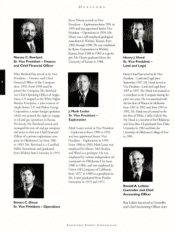Chesapeake Energy 1997 Annual Report Download - page 18
Download and view the complete annual report
Please find page 18 of the 1997 Chesapeake Energy annual report below. You can navigate through the pages in the report by either clicking on the pages listed below, or by using the keyword search tool below to find specific information within the annual report.
PART I
ITEM 1. Business
Overview
Chesapeake Energy Corporation ("Chesapeake" or the "Company") is an independent energy company
which utilizes advanced drilling and completion technologies to explore for and produce oil and natural gas.
The Company has traditionally been among the most active drillers of new wells in the United States.
From inception in 1989 through June 30, 1997, Chesapeake drilled and participated in a total of 736 gross
(294 net) wells, of which 691 gross (276 net) wells were completed. From its first full fiscal year of operation
ended June 30, 1990 to the fiscal year ended June 30, 1997, the Company's estimated proved reserves
increased to 403 Bcfe from 11 Bcfe, annual production increased to 79 Bcfe from 0.2 Bcfe, total revenue
increased to $280 million from $0.6 million, and total assets increased to $949 million from $8 million. Despite
this overall favorable record of growth, in fiscal 1997 the Company incurred a net loss of $183 million
primarily as a result of a $236 million impairment of its oil and gas properties. The impairment was the result
of its capitalized costs of oil and gas properties exceeding the estimated present value of future net revenues
from the Company's proved reserves at June 30, 1997.
In response to the fiscal 1997 loss, Chesapeake has revised its fiscal 1998 business strategy. These
revisions include slowing its exploration pace in the Louisiana Austin Chalk Trend ("Louisiana Trend") and
concentrating its Louisiana Trend drilling activities in Masters Creek; utilizing more extensive use of 3-D
seismic prior to conducting drilling operations; reducing the acquisition of additional unproven leasehold; and
selectively acquiring proved reserves as a complement to its primary strategy of developing reserves through
the drilibit.
Reference is made to the "Glossary" that appears at the end of this Item 1 for definitions of certain terms
used in this Form 10-K.
Description of Business
Since its inception, Chesapeake's primary business strategy has been growth through the drillbit. Using
this strategy, the Company has expanded its reserves and production through the acquisition and subsequent
development of large blocks of acreage.
From inception through fiscal 1994, the Company concentrated its undeveloped leasehold acquisitions
and associated drilling in the Giddings Field of southern Texas and the Golden Trend Field of southern
Oklahoma. Beginning in fiscal 1995, Chesapeake initiated development of new project areas that were either
extensions of the Company's historical focus in the Giddings and Golden Trend Fields or new areas in which
the Company believed had similar characteristics. These additional project areas included the Knox Field in
southern Oklahoma, the Sholem Alechem Field in southern Oklahoma, the Louisiana Trend, the Arkoma
Basin in southeastern Oklahoma, the Lovington area in eastern New Mexico, and the Williston Basin in
eastern Montana and western North Dakota. In fiscal 1997, the Company also added a large exploration
project in Wharton County, Texas.
The Company invested approximately $179 million, including capitalized interest, to acquire over
one million acres of leasehold in the Louisiana Trend from fiscal 1995 through fiscal 1997, and an additional
$163 million in drilling to explore this leasehold in fiscal 1996 and 1997. Of the Company's six project areas
identified in the Louisiana Trend, only in the Masters Creek area has the Company consistently found
commercial quantities of oil and gas in the Austin Chalk formation.
As of June 30, 1997 the Company owned over two million net undeveloped acres in its leasehold
inventory. The Company expects that its inventory of proved and unproved drilling locations will continue to
be an important source of new reserves, production and cash flow over the next few years. The Louisiana
Trend continues to be a key element of this existing inventory.
1
























